Sixteen Glasgow Volunteers in the Irish Revolution
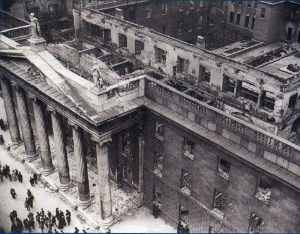
The story of sixteen Glasgow based Irish Volunteers 1916-1923. By Thomas Tormey
At Easter 1916 sixteen members of the Glasgow unit of the Irish Volunteers fought in Dublin during the insurrection. [1]
A part of Scottish life for 200 years, Scotland’s Irish community has also been part of the global Irish diaspora during that time. As such it has played a role in the transnational movements associated with the campaigns for various forms of Irish independence. This was vividly illustrated during the 1916 Rising when Volunteers travelled from the west of Scotland to join the rebellion.
This article is a short history of the revolutionary involvement of those members of the Scottish unit of the Irish Volunteers who fought in Dublin in 1916.
What follows below is a short history of the revolutionary involvement of those members of the Scottish unit of the Irish Volunteers who fought in Dublin in 1916, through the guerrilla campaign by the Irish Republican Army [IRA] against the British from 1919-21 and during the Irish Civil War that followed the split in the IRA over the Treaty with the British government.[2]
These sixteen are a small proportion of the roughly 250 Irish Volunteers in Scotland in 1916. This latter figure rose to around 2,500 by the time of Truce between the Republicans and the British in 1921.[3] According to Gerard Noonan roughly 250 members of the Scottish Brigade of the IRA fought in the Irish Civil War on the pro-Treaty side and five died. While roughly 50 fought on the Republican side.[4]
Of course, these figures are dwarfed by the numbers who fought in the Great War. Elaine Mac Farland states that 30,000 Glaswegian Catholics were in the British armed forces in 1916.[5] While Géraldine Vaughan quotes a figure of 15,000 Irish Catholics from Scotland for 1915, that is before conscription had been introduced.[6]
Given that around a fifth of these men had joined Irish Regiments, and that these regiments were heavily involved in British efforts to supress the Rising, it is possible that there were more Glaswegian Catholics voluntarily fighting for the British than against them in Dublin in 1916. Stephen Coyle lists three Crown Forces fatalities of the fighting with Glasgow addresses.[7]
Why did they go to fight in Dublin?
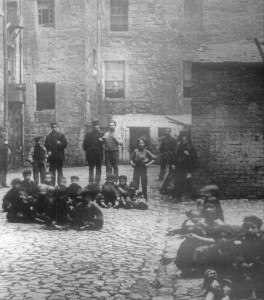
Why did only 16 of the 250 active Scottish Volunteers travel to Dublin to fight in the Rising?
It is worth noting at this point that the size and, indeed, the seeming militancy of this sample may have been affected by the strong anti-insurrectionist cadre within the Irish Republican Brotherhood [IRB] in Scotland.
Several leading Glasgow Fenians appear to have disapproved of plans for a Rising and to have both avoided participation themselves and disrupted attempts to enlist support for it.[8] One leader resigned over the plans to hold an insurrection while another withheld orders from Dublin telling the Scottish members to travel for the uprising.
Thus, the sample may be taken to be more militant than other groups of 1916 veterans, consisting, as it largely does, of men who left Glasgow on the run due to their participation in raids for arms and explosives in various quarries and shipyards. [9]
Several leading Glasgow Fenians appear to have disapproved of plans for a Rising
Of this cohort of sixteen, listed above, eight appear to have been Scottish-born or living in Scotland from a very young age, seven had grown up in Ireland and had migrated to Scotland, leaving one that, so far, cannot be traced. Five of those who had grown up in Ireland were from Dublin. Emphasising the close connections between these two port cities in this era of ferry travel.
A Family affair
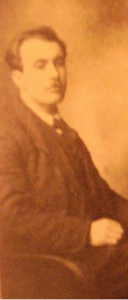
This same group illustrates how membership of the Irish Volunteers was often a family affair. It contains two sets of brothers. One set of brothers, the McGalloghys, grew up in Glasgow, one set, the O’Flanagans, in Dublin.
The O’Flanagan’s of Moore Street were a staunchly republican family whose father had been involved in the IRB for many decades. Four O’Flanagan brothers, including two who had not been resident in Glasgow, were ‘out’ during Easter week.[10]
The other set of brothers, the McGalloghlys, were Lanarkshire born. John, the youngest, had never been to Ireland, prior to travelling to Dublin for the Rising. The familial nature of Irish Republican activism in Scotland remained a constant throughout the revolutionary period. According to Gerard Noonan, the Scottish Brigade contained at least 22 sets of brothers during the 1919-21 period.[11]
To underline this point about family recruitment, a further two members of the group had brothers who were in the Volunteers but who either were not members of the Scottish unit or did not travel to Dublin for the Rising.
Membership of the Irish Volunteers was often a family affair, with sets of brothers being particularly common.
One such Volunteer, who was to prove the most prominent of the Glasgow men in the Independence struggle, was Séamus Robinson, who had been born in Belfast but moved to Scotland as a teenager. Having briefly been a monk, he left the religious life to join the Irish Volunteers and IRB with his brother Joe in 1913.
Séamus’s witness statement noted that he was never formally attested to the Volunteers. They and he simply took each other for granted. Joe Robinson did not serve in the Rising, having been arrested for arms smuggling along with Scottish Republican Séamus Reader in January 1916.
Francis Scullin’s brother, Patrick Scullin, is listed as being Glasgow-based in Séamus Robinson’s bureau statement. However, no evidence could be found to suggest that Patrick was ever a member of the Irish Volunteers in Scotland.[12]
It is probable that Patrick was mistakenly included in Robinson’s list. Likely he was associated with the Glaswegian contingent during the period leading up to the Rising when many Volunteers from Britain lived together in billets around Dublin (including the fabled ‘Kimmage Garrison’, one of whom was Michael Collins) and also during the Easter week itself and the period of internment which followed.[13]
Interestingly, of those Volunteers who had a brother in the Volunteers, but not in our sample, one grew up in Glasgow, one was a recent immigrant.
In Dublin in 1916
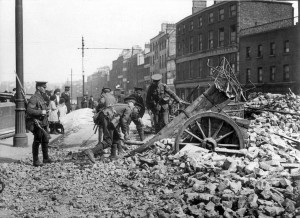
The Glaswegian contingent lacked neither militancy nor valour when compared to the local Republican units in Dublin during the Easter Rising.
There is absolutely no sense of them being tourists, of it not being ‘their fight’, or of them being in Ireland simply to avoid conscription, which had been introduced in Britain in early 1916.
One set of brothers, the O’Flanagan’s, were heavily involved in the fighting around North King Street, the second heaviest battle in the Rising, after that at Mount Street. Another O’Flanagan brother, Patrick Joseph, better known as Padjoe, who had been resident in Dublin rather than Glasgow, was killed defending ‘Reilly’s fort’ at the corner of North King Street and Church Street.[14]
The Glaswegian contingent lacked neither militancy nor valour when compared to the local Republican units in Dublin during the Easter Rising.
Most of the rest of the Glasgow contingent helped to clear O’Connell Street after the Rebels had taken over the General Post Office, their accents causing understandable confusion amongst local civilians.[15] Seán Hegarty was responsible for raising the flag of the Irish Republic above the GPO. Charles Carrigan, a Scottish-born member of John Wheatley’s Catholic Socialist Society was one of the last rebel casualties of Easter week. Carrigan died having being caught in the open by British machine gun fire following the evacuation of the GPO.[16]
Internment
All of the Glasgow contingent were captured following the Rising, perhaps they lacked the local knowledge that allowed so many Rebels to escape. All but one were eventually interned in Frongoch prison camp in north Wales before being released with the other internees in various batches during the second half of 1916.
Séamas Robinson was moved to Reading jail from Frongoch having been blamed for a strike in which some internees demanded trade union wages for the road-making work the War Office were attempting to force them to do.[17]
The only Glasgow Volunteer to be sentenced, rather than interned, was John McGalloghly. McGalloghly was convicted for holding up an officer, Lieutenant Stanhope King of the Royal Inniskilling Fusiliers.[18] This is a noteworthy incident: a Scottish born-and-bred Catholic rebel holding up an Irish, almost-certainly Protestant, officer of the Royal Inniskilling Fusiliers Regiment of the British Army.
Most of the Glasgow Rising veterans remained in the movement after they were released from internment in 1917.
Of the sixteen who travelled from Glasgow to Dublin to fight, two died before the War of Independence, Carrigan, killed in action during Easter week, and Alexander Carmichael. Carmichael died of Addison’s disease in 1920 and was buried at his own request in Glasnevin Cemetery in Dublin.[19] Often referred to as Sandy or Alec, Carmichael had been prominent during the arms raids of 1915 and was a company captain from 1917, having played a leading role in the re-organisation of the Volunteers in Glasgow after the mass release of prisoners from Frongoch in late 1916.[20]
In terms of post-Rising activism, all, including McGalloghly were involved in re-organising the Volunteers upon their release in late 1916 and early 1917. By the time of the Truce with the British on 11 July 1921 only 3 of the 14 who remained alive had completely dropped out of the IRA. That gives a 21% drop out figure with 79% who were still members.
This compares to a roughly 47% drop out figure for Irish Citizen Army veterans of the fighting in Dublin. Usually the proportion of Irish Volunteers who have some post-rising involvement in the military side is around 60%, significantly lower than in this sample.[21] In this sample it is at least 70%.
As mentioned above, it is likely the militancy of the group dealt with here has been increased by the reduced numbers who travelled from Scotland to take part in the Rising as a result of the disruption caused by senior IRB men there.
The stories behind the numbers
Of the three who were no longer militarily active at the Truce in 1921, two were still politically active. Cormac Turner remained a member of the Irish Republican Brotherhood. Turner had dropped out of the IRA in 1919. Bernard McMullen dropped out to become a trade union organiser having moved to Limerick for work.
While many revolutionaries joined different units as they migrated for economic reasons, as can be seen repeatedly in the case of the IRA in Scotland, the partly social nature of Volunteer activism meant that many did not, so McMullan’s actions were not unusual. The only Volunteer who appears to have completely dropped out by the time of the Truce was Barney Friel. Friel had served a three-year sentence of imprisonment having been arrested for arms smuggling in 1918.
Some of our cohort took a behind the scenes role in armed resistance. Volunteers could have such activity recognised as military service if they were “key men” providing support to “fighting men” in areas where armed resistance was taking place.[22]
Patrick Mahon was involved in the transport and storage of arms. Frank Scullin, in his regular occupation as a lamp-lighter with Dublin Corporation, was sometimes called upon to extinguish lights in certain areas in order to hinder the British and/or facilitate IRA operations.
While most of the Glasgow Rising veterans were active during the War of Independence, only two on IRA ‘active service’.
Another former member of the Glasgow unit, Michael O’Flanagan, used money paid to him by the Green Cross, a Republican prisoner’s welfare association, to open a poultry business in Dublin’s south inner city. The business became an arms dump and a post-resante centre for IRA General Head Quarters. O’Flanagan also won the contract for supplying poultry to the local British Army barracks.
The fact that a man who had to leave Glasgow on the run in 1915 and fought in the Easter Rising could be awarded such a contract says much about British intelligence failures or perhaps complacency in this period.[23] Although it should be noted that Michael O’Flanagan and his brother Francis were arrested in the latter part of 1920.
Francis O’Flanagan was one of two Volunteers to see actual combat in the War of Independence. Francis O’Flanagan had come over to Dublin in 1916 later than his brother. Francis was involved in the attack at Monk’s Bakery, September 1920, in which three very young British soldiers of the Duke of Wellington’s Regiment were killed after resisting an IRA attempt to relieve them of their arms. This was the attack for which republican icon Kevin Barry was executed.[24]
Francis was also involved in an attempted rescue of Kevin Barry that was called off because of the crowds surrounding Mountjoy Prison where he was held. Barry was the first Republican to be executed since 1916 and the three soldiers were the British Army’s first fatal casualties in Dublin since 1916.
Both O’Flanagan brothers had joined C Company of the 1st Battalion of the Dublin Brigade on their return from Glasgow. Francis had moved unit to the newly established H Company as a section commander in 1918. H Company was established as C Company was simply getting too big. This was a common experience for ordinary rank-and-file Rising veterans who regularly moved up the ranks and were used as experienced cadres to stiffen newly organised units in the Dublin Brigade. This phenomenon continued to 1923 on both sides of the Treaty divide.
The most active Volunteer of the Glasgow contingent was Séamus Robinson. Séamus Robinson was an ordinary Volunteer prior to his brother Joe’s arrest in January 1916. Séamus campaigned on his brother’s behalf following the arrest. This appears to have radicalised him to a degree as well as convincing other leading Republicans of his bona fides and competence. Having fought in the GPO during Easter week, Séamus Robinson travelled to Tipperary to help organise the Volunteers there after his release from post-Rising internment.
Appointed officer commanding the Third Tipperary Brigade of the IRA, a particularly militant unit, Robinson led the IRA action responsible for the first Crown Forces casualties of the War, the shooting of two policemen at Soloheadbeg on 21 January 1919 and was involved in several other well-known incidents, including the Knocklong train rescue.
Soloheadbeg and Knocklong occurred early in the conflict before Ireland became inured to violence and when there were few other events competing for attention. Robinson stated that he had been trying to start a guerrilla war, he did not think that the war had ended at the surrender in 1916, rather he felt that this was the same war that had been ongoing since 1172 (i.e. the Norman invasion of Ireland).
Robinson felt that, as an outsider he never got the credit he deserved in either written history or in the local folklore of the War in Tipperary. He believed that this was because his upbringing in Belfast and Glasgow meant that he was seen as an urbanite, rather than as Scottish.[25]
In Scotland
Séamus Robinson’s brother, Joe, along with the man he was arrested with in 1916, Séamus Reader, were leading figures in the Scottish Brigade of the Irish Volunteers/IRA between their release in 1917 and 1921. It is noticeable, however, that none of the veterans of the Dublin fighting who had travelled from Glasgow were involved in the IRA/IRB gun-running activities there, which were led by Joe Vize and Joe Furlong.
These operations were the main Volunteer effort in Scotland and were often kept apart from the routine work of the Scottish Brigade which continued to drill and train in a similar manner to IRA companies in the quieter parts of Ireland.[26] John Carney acted almost as a dummy o/c Scotland and often toured the central belt inspecting companies and liaising with political support groups.[27]
Most IRA activity in Scotland involved fund raising and gun running, but there was also a celebrated ambush of police van in Glasgow in 1921.
Perhaps the most famous incident that took place in Scotland during the Irish independence struggle was the ‘Smashing of the van’ incident – so named for its similarity an attempted prisoner rescue in Manchester in 1867 that led to the hanging of the Manchester Martyrs.
In the ‘Glasgow Smashing of the Van’, on May 4, 1921, local IRA members mounted an ambush on a police prison van in an attempt to free Frank Carty of the Sligo Brigade who had been on the run in Scotland before his arrest. Two Scottish policemen were shot and one killed in the failed rescue attempt, which prompted a crackdown on Irish Republicans in Scotland. IRA GHQ, and some members of the local battalion, had disapproved of the action, fearing just such an outcome.[28]
Of the Rising veterans, Paddy Morrin and Patrick Maguire are listed as members of the Scottish Brigade, but they are not listed as being heavily involved in the gun-running or as being arrested for the ‘smashing of the van’ incident, although they were active with their companies.[29]
Indeed, only one of our sample, Séamus McGalloghly, was arrested for the shooting incident during the attempt to free Frank Carty in Glasgow.[30]
The McGalloghly brothers had left the Clydeside unit of the Volunteers in 1917 following the split that had been engendered by arguments over the senior Scottish Republicans opposition to the Rising. Both however re-joined in Manchester, although there is contradictory evidence as to when exactly.
Both were involved in arms smuggling as the IRA units in Great Britain moved from operating through Clydeside to using Liverpool docks and the Manchester Brigade became a key link in the chain. Séamus McGalloghly was taken ill while on a run in Scotland and ended up in a Glasgow hospital where he was arrested.
Upon release, he was moved to Dublin to convalesce although he did die from his illness in 1924. His brother John was arrested in May 1921 during a police round up that followed a burst of IRA sabotage activity in the Lancashire countryside.
Lastly, it not entirely clear what role Seán Hegarty and John Lafferty played in the War of Independence. Obituaries for Hegarty, carried in both the Irish Independent and Irish Press, mention or imply his involvement. The Press tribute is a little opaque as a result of that paper’s reluctance to draw a distinction between the pre and post-Truce IRA; it described Hegarty as “an active member of the IRA from the Rising in 1916 until the ‘Cease Fire’ order”, meaning Frank Aiken’s order of 1923.
The Independent recorded that Hegarty “took an active part against the Black-and-Tans and later opposed the Treaty”.[31] John Lafferty appears to have been a member of his local company without engaging in any major activity until 1922 when he was enrolled in the National Army in Donegal as in anticipation of the so called ‘Joint IRA offensive’, the attack on Northern Ireland involving both pro-and anti-Treaty IRA members that was conducted in the spring of 1922.
Civil War
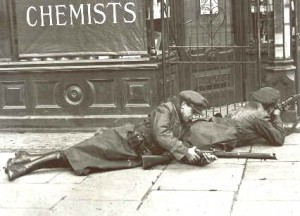
There was little support for the Treaty among the Glasgow Volunteer veterans of 1916. Lafferty and Cormac Turner, who had dropped out of the Volunteers in 1919 but remained in the IRB in Dublin were the only two of the group to ever join the pro-Treaty National Army.
This is significant given the number of Scottish Volunteers who fought with the National Army in the Civil War. Indeed, the majority of the Scottish Brigade from the War of Independence, including much of the more active portion, backed the Treaty.[32]
The majority of the Scottish Volunteers backed the Treaty, but most Glasgow Rising veterans opposed it.
This was possibly due to the personal loyalty the IRB gun-runners felt towards Michael Collins.
John Lafferty found himself in an awkward situation following the beginning of the Civil War as he was being trained as a member of the National Army but did not support the Treaty or the new Provisional Government. A company of Volunteers who travelled from Coatbridge, six miles east of Glasgow, to Dublin found themselves in this situation also.[33]
Neither Cormac Turner nor Lafferty can properly be considered to have ‘fought’ in the Civil War: Turner only joined a rear echelon unit of the National Army in 1923. Lafferty was confined to barracks for much of 1922 having refused orders from leading Ulster pro-Treatyites Dan McKenna and Seán Haughey to attack the anti-Treaty IRA in Donegal.
The soft support for the Treaty among this group is emphasised by the fact that the lone National Army member of 1923, Cormac Turner, was a prominent member of Fianna Fáil in later life.[34] In this Turner was unusual but not exceptional. Indeed, the path from a National Army background to the ‘Soldiers of Destiny’ was also trod by Seán Haughey’s son, Charles James.
Another five of the Glasgow veterans of Easter week avoided taking sides in the Civil War. Barney Friel stayed neutral having dropped out on his release from imprisonment. Bernard McMullen also remained neutral although he was imprisoned in Dundalk for a period by the pro-Treatyites in 1922.
John McGalloghly, having moved to Ireland in February 1922 following his release from imprisonment, refused to take sides in the IRA split that was calcifying during that spring. McGalloghly’s brother Séamus was in Dublin’s Four Courts building, which was occupied by the anti-Treaty IRA in April 1922 and attacked at the start of the Civil War on June 28. However, Séamus was in a non-combatant role due to his sickness.
Like John McGalloghly, Michael O’Flanagan had also resolved to stay neutral during the split in the IRA in 1922. O’Flanagan found himself rendering some assistance to the anti-Treaty forces, putting his car at the disposal of elements of the Dublin Brigade and later providing food and shelter to Séamus Reader and a group of Glasgow Republicans who had travelled Dublin to fight in the Civil War. Reader and his crew had escaped from the fighting in Dublin City Centre following the collapse of Republican resistance and later returned to Glasgow on a normal civilian boat.[35]
Seven of our cohort opposed the Treaty as members of the IRA. Although Patrick Morrin and Patrick Maguire remained with their companies for the Civil War they do not seem to have travelled to Dublin with Reader. Four others, Seán Hegarty, Patrick Mahon, Frank O’Flanagan and Frank Scullin, all took part in the fighting in Dublin city centre at the start of the Civil War in June and July 1922.
All four saw much more combat during the Civil War than they had in the War of Independence. Their arrests: Patrick Mahon on surrender, Frank O’Flanagan a month later and Frank Scullin in early 1923, after taking part in a large number of guerrilla actions in Dublin, are typical of the broad range of experiences of anti-Treaty Volunteers in Dublin, many of whom saw more fighting in the Civil War than before the Truce.
Hegarty, Mahon and Frank Scullin took part in the great prisoners’ hunger strike in late 1923, Scullin lasting 35 days before giving up. Hegarty’s health was affected in later life by his involvement in at least two hunger strikes during the revolutionary period.[36] Mahon was among the last group of Republicans to be released.
Séamus Robinson spent much of the Civil War working as aide-de-camp to Éamon de Valera, then the political leader of the anti-Treaty side. Robinson is a fitting veteran to conclude with as he is an extremely good example of the integration of the Scottish sections of the Irish Republican movement into the wider whole. He was later a Fianna Fáil senator, a board member of the Bureau of Military History, and a referee for the military service pensions board, and thus intimately involved in the production of a great deal of the source material for this article.[37]
Context and conclusion
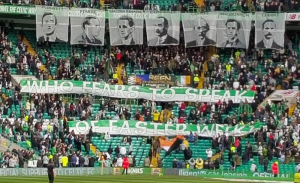
Overall, the Volunteers in this sample, that is those who were members of the Glasgow Regiment of the Irish Volunteers and who travelled to Dublin to fight in the Rising, differ from the Irish-based Volunteer veterans of Easter week in three important respects.
Firstly, very few of them drop out, and even those that do are relatively active. Two of the three that dropped out before the Truce remained politically active and the third only dropped out having served a three-year jail sentence. Secondly, very few of them serve with the Scottish Brigade in the War of Independence.
The stories of the Glasgow Volunteers of Easter week run like a thread through both the War of Independence and Civil War.
Usually the figure for Volunteers moving brigade is about 5%.[38] Although in this case the situation is not directly comparable given the number of the sample who were Dubliners who had only been in Glasgow on a temporary basis. Lastly, only one of the group aided the pro-Treaty side during the Civil War. This is deeply ironic given how many active members of the Scottish Brigade in the War of Independence later joined the National Army. However, in spite of the well-known examples of split friendships and families, IRA members tended to make up their minds on the Treaty issue along social or familial lines.[39]
The stories of the Glasgow Volunteers of Easter week run like a thread through both the War of Independence and Civil War. This highlights very well the integration of the Scottish section of the Irish diaspora with the wider separatist movement. From brigade commanders to ordinary Volunteers, from political activists to gun-runners; from ‘key men’ to ‘fighting men’, and on to hunger strikers, their lives ran the gamut of militant republican activist experience.
Séamus Robinson’s demand for ‘trade union wages’ for internees in Frongoch, allied to Brian McMullen’s labour activism, and indeed Charles Carrigan’s membership of the Catholic Socialist Society indicate that the Irish in Glasgow of this period had strong links to the left-wing sections of Irish Republicanism and were themselves more left leaning than other Irish Volunteer veterans. This befits Clydeside’s radical reputation.
Also, Séamus Robinson’s comment about 1172 places these Volunteers very much in the nationalist milieu of early twentieth century Europe. Indeed, it could be argued that this cohort of Easter week veterans resemble very much the veterans of the Great War.
Robert Gerwarth has described how a culture of defeat, either military in the case of the Central Powers, or diplomatic in the case of Italy drove the paroxysms of violence that plagued continental Europe in the period following 1918.[40]
It might further be argued that there are definite parallels between the reactions of those soldiers to the outcome of the war, the “the mobilizing power of defeat”, which included a refusal to accept the reversal, and the reaction of those Volunteers who travelled from Glasgow to Dublin in 1916 to their defeat in the Rising, the failure to gain recognition for the Irish Republic at Versailles, the Government of Ireland Act 1920, and the Anglo-Irish Treaty of 1922.